If you’re searching for a dessert that brings the taste of the tropics right to your table, Filipino mango sago is the answer; it’s a creamy, chilled treat that’s been a beloved favorite in Filipino homes for generations. The natural sweetness of ripe mangoes, the chewy bite of sago pearls, and the richness of coconut milk come together perfectly; it’s like sunshine in a bowl, ready to cool you down on the hottest days.
What makes Filipino mango sago truly special is how easy it is to make; with just four simple ingredients and 15 minutes, you can whip up a dessert that’s as good as any you’d find in a restaurant. Once you try this classic Filipino mango sago, you’ll see why it’s considered one of the best summer desserts in Asian cuisine.
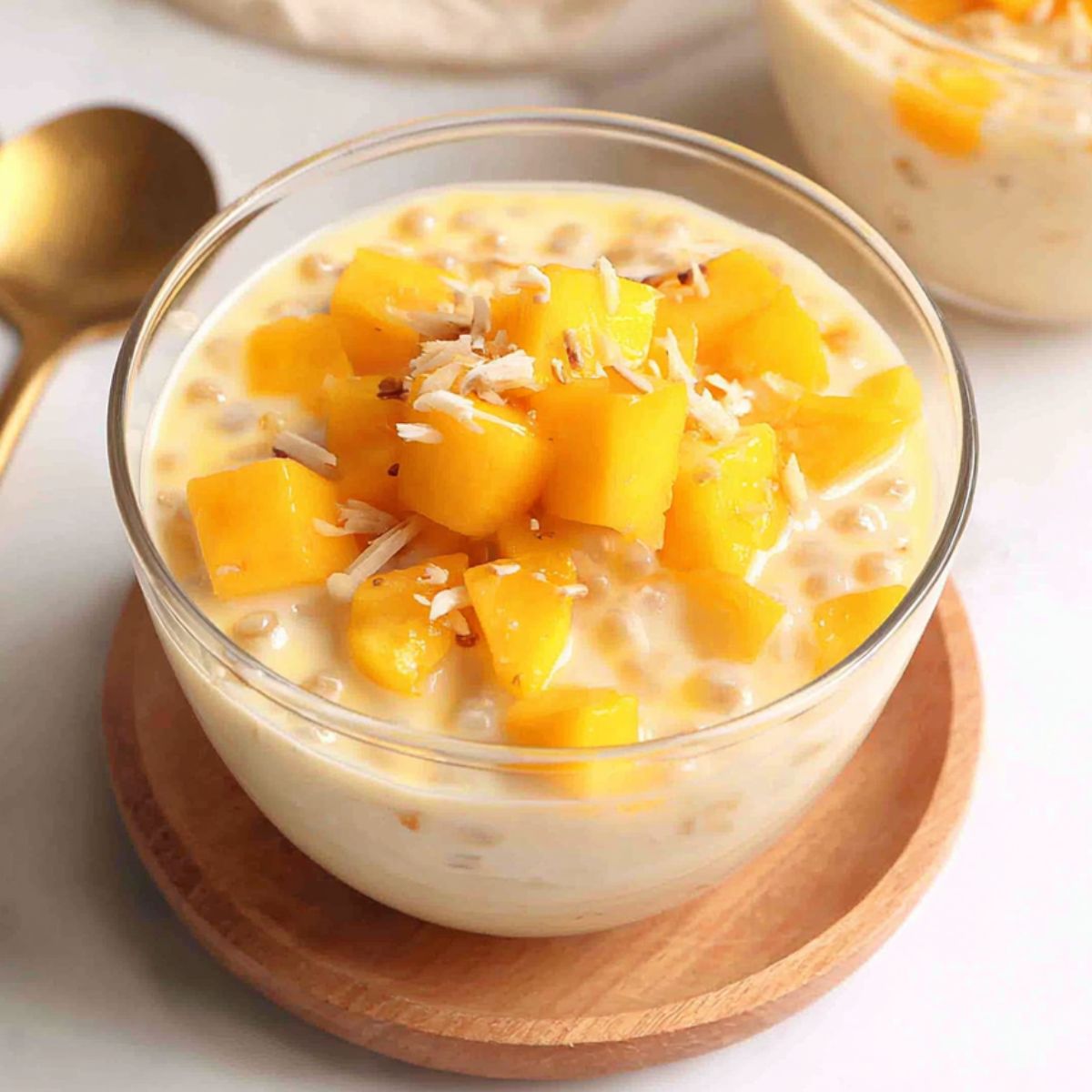
Background & Why This Recipe Stands Out
Let me take you behind the scenes of Filipino mango sago; a dessert that’s as rich in history as it is in flavor. In the Philippines, mangoes are often called the king of fruits; and it’s no surprise that this creamy, chilled pudding is a true showcase of what Filipino cuisine does best; bringing together fresh, vibrant ingredients in perfect harmony.
Filipino mango sago has been loved for generations, not only in the Philippines but across Asia; and if you’ve ever asked yourself, “is mango sago Filipino?” the answer is a proud yes. While you’ll find mango sago in many Asian countries, the Filipino version is special; thanks to its generous use of sweet, ripe mangoes and that silky coconut milk base we all crave.
What really makes this Filipino mango sago recipe stand out is its beautiful simplicity; no complicated steps or fancy tools needed. With just a few quality ingredients and a little care, you’ll create a tropical fruit dessert that’s both refreshing and deeply satisfying. It pairs perfectly with other Filipino classics like leche flan or halo-halo; making it the ideal addition to family feasts and celebrations.
Jump to:
Ingredients
- Condensed milk
- Ripe mangoes
- Cooked sago pearls (or tapioca pearls)
- Coconut milk
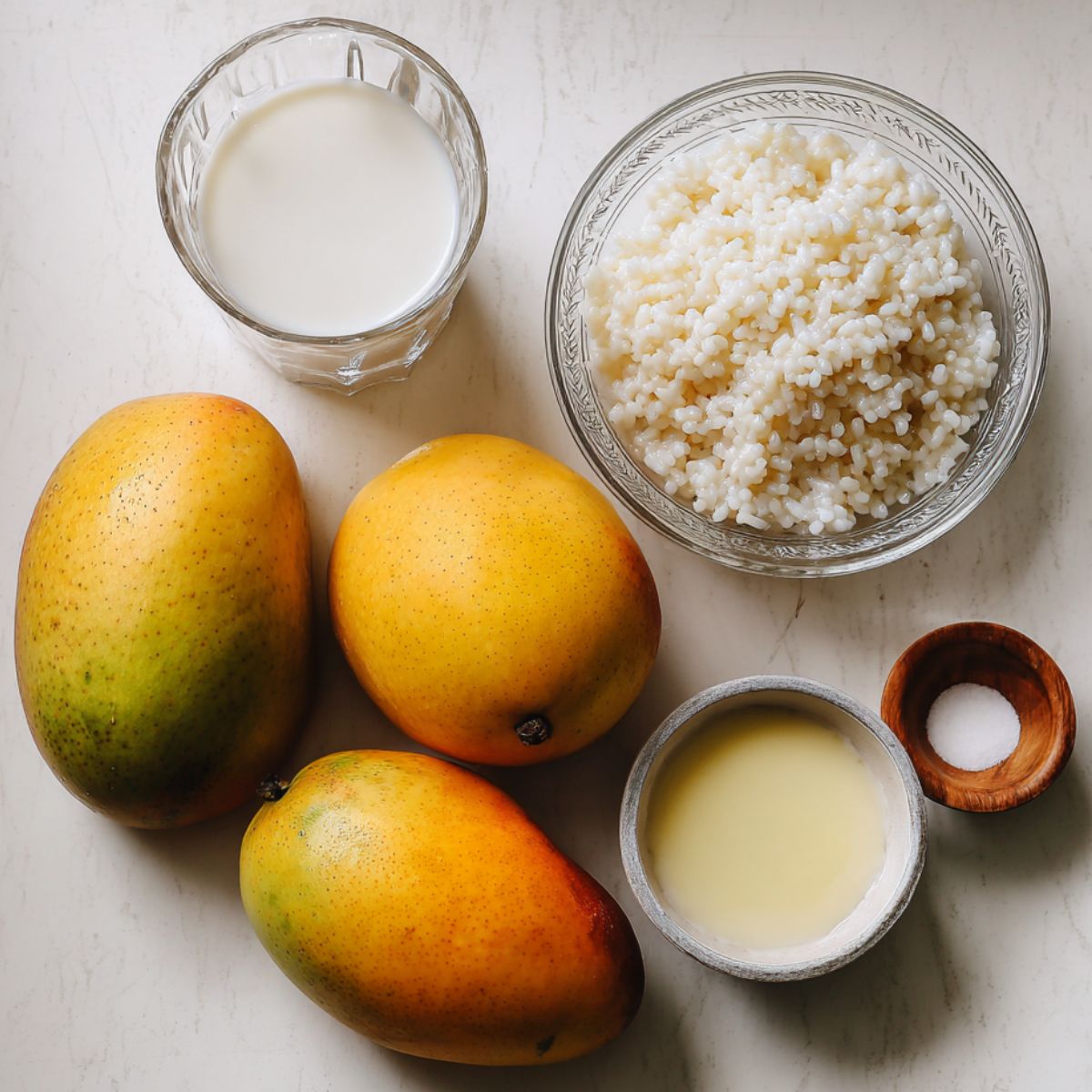
See recipe card for quantities.
Instructions
Cook the Sago Pearls
- Bring a pot of water to boil, add the sago pearls, and cook for 10-15 minutes until they become translucent with just a tiny white center.
- Drain and rinse with cold water to stop the cooking process. This step is crucial because properly cooked sago pearls should be chewy but not hard or mushy.
Prepare the Mangoes
- Wash and peel your ripe mangoes, then cut them into small cubes.
- For this mango sago recipe Filipino style, you want about 1.5 cups of mango chunks. The key is using mangoes that are ripe but still firm enough to hold their shape.
Mix the Creamy Base
- In a large mixing bowl, combine the coconut milk and condensed milk.
- Whisk until smooth and well combined.
- Add the cooked sago pearls and mango chunks to the creamy mixture.
- Gently fold everything together, being careful not to break the mango pieces.
Chill and Serve
- Transfer the mixture to individual serving glasses or one large bowl.
- Cover and refrigerate for at least 2 hours or until well chilled. The chilling time allows all the flavors to meld together perfectly.
- Just before serving, give it a gentle stir and add a few extra mango chunks on top for presentation.
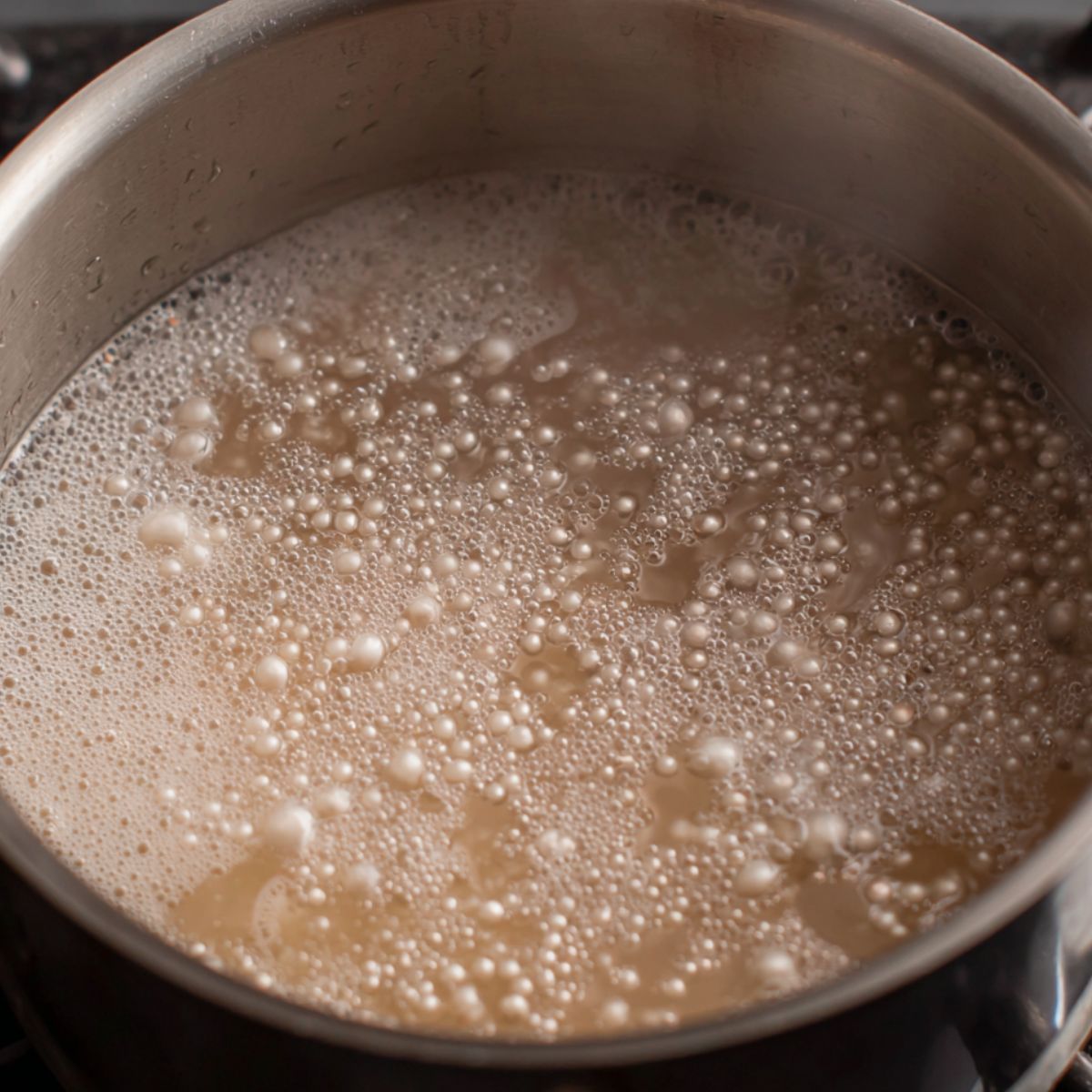
- Step 1: Cook the Sago Pearls
Cook the sago pearls until translucent with a small white center
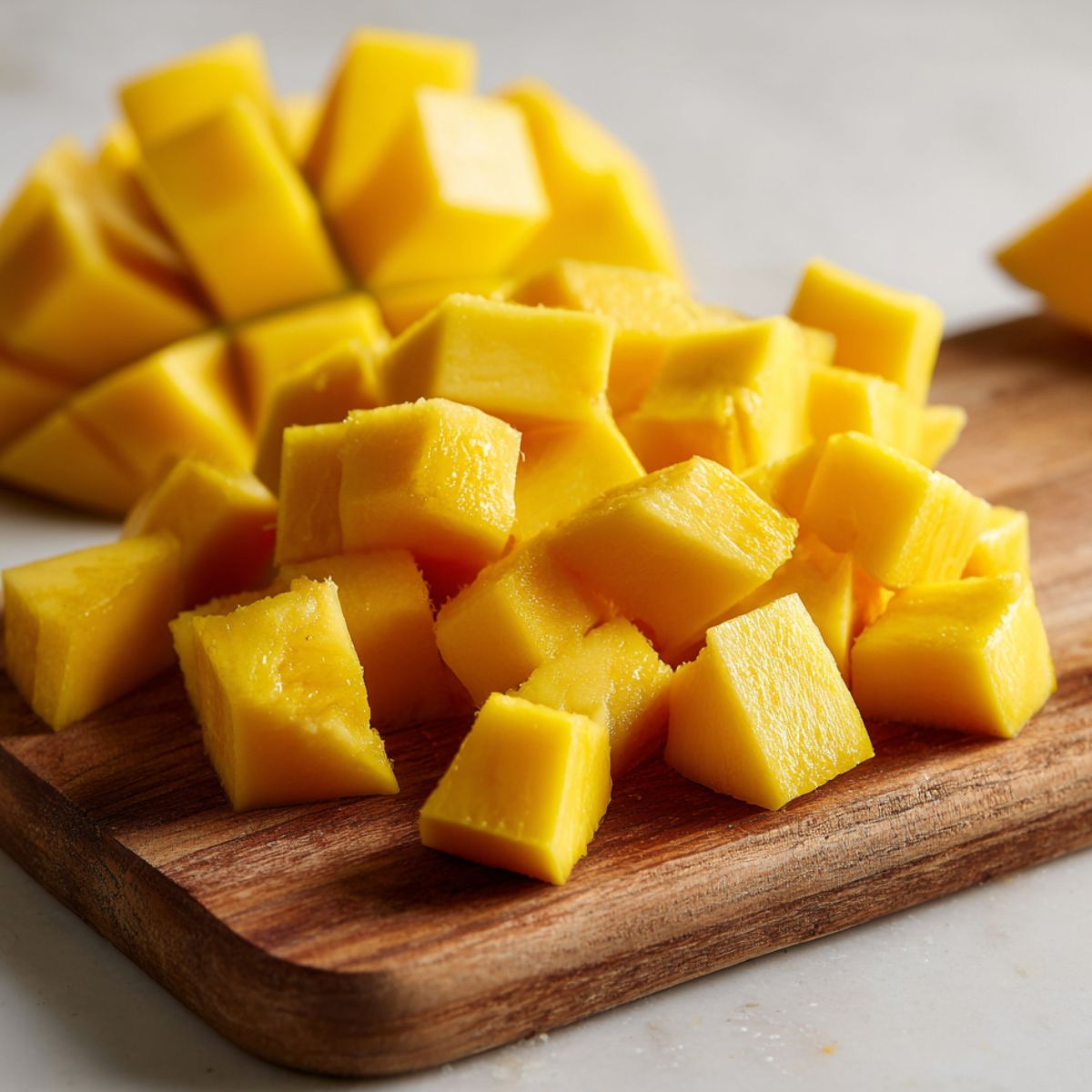
- Step 2: Prepare the Mangoes
Cut the mangoes into small, firm chunks
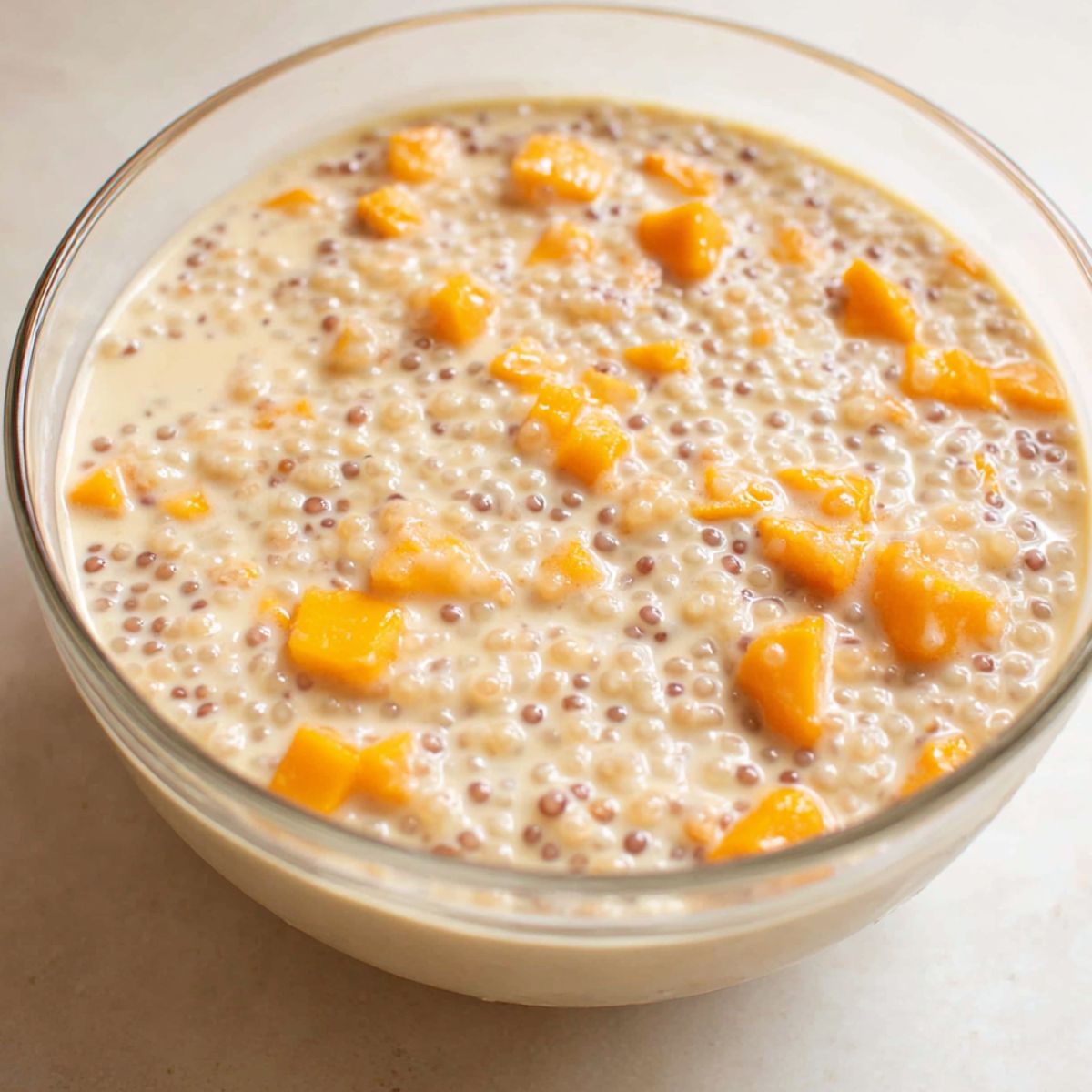
- Step 3: Mix the Creamy Base
Combine the coconut milk, condensed milk, sago, and mango
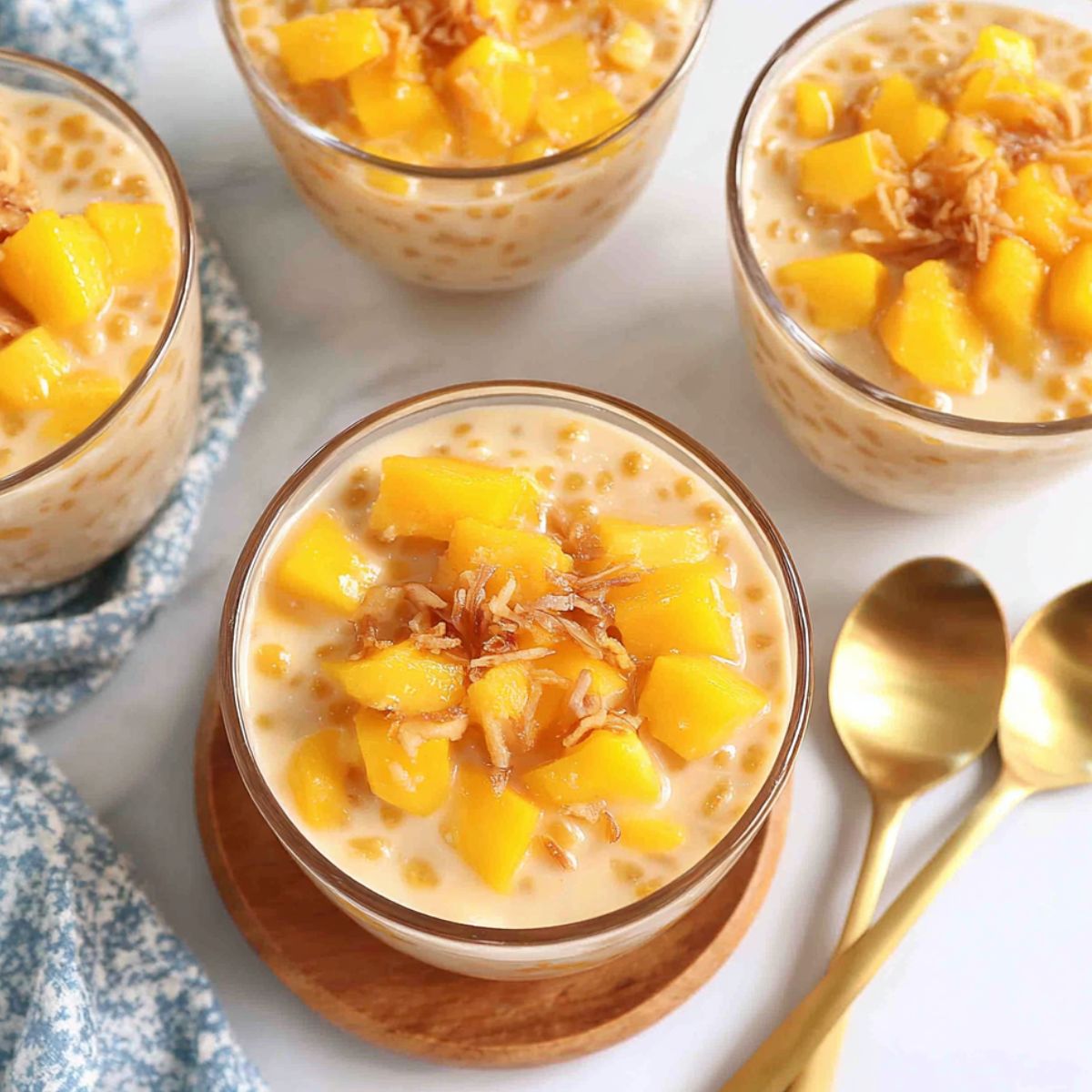
- Step 4: Chill and Serve
Chill well and serve cold for best flavor
Hints & Expert Cooking Tips for Filipino Mango Sago
- Optional twist; a small splash of vanilla extract can subtly enhance the tropical flavors, though it’s entirely up to your taste.
- Choose the right mangoes; always go for ripe but firm mangoes. They should yield slightly when pressed but stay intact. This keeps your Filipino mango sago fresh and flavorful without turning mushy.
- Rinse your sago pearls in cold water; never skip this step. A cold rinse stops the cooking process and prevents the pearls from sticking together, giving your Filipino mango sago that perfect chewy texture.
- Use full-fat coconut milk; the richness of full-fat coconut milk is key to achieving that creamy, luxurious mouthfeel that defines an authentic Filipino mango sago. Light versions just don’t deliver the same depth.
- Create texture contrast; try pureeing half the mangoes while leaving the other half in chunks. This trick gives your Filipino mango sago a lovely blend of smooth and juicy bits in every spoonful.
- Serve ice-cold; temperature matters. Make sure to chill the dessert thoroughly before serving ; Filipino mango sago is at its best when refreshingly cold.
Smart Substitutions for Filipino Mango Sago
- Coconut milk substitute; in a pinch, you can mix heavy cream with a splash of coconut extract. It’s not quite the same, but it does the job for a quick Filipino mango sago fix.
- For a dairy-free version; swap regular condensed milk with coconut condensed milk. This keeps your Filipino mango sago creamy and rich without the dairy.
- For lower sugar; replace condensed milk with evaporated milk and sweeten gently with honey. You’ll still enjoy that signature Filipino mango sago flavor but with a lighter touch.
- No sago pearls on hand?; cooked tapioca pearls or even small boba pearls can step in. They provide the same chewy bite that makes Filipino mango sago so satisfying.
- Mango alternatives; while nothing beats fresh ripe mangoes, thawed frozen mango chunks work well if fresh isn’t available. Your Filipino mango sago will still taste delicious.
Recipe Variations & Dietary Modifications
- Creative flavor variations; add a pinch of cardamom or a splash of pandan extract for a unique flavor profile. Some families like to mix in small pieces of jackfruit or young coconut strips to make their Filipino mango sago even more tropical and fun.
- Vegan version; Filipino mango sago is naturally vegan when you use coconut condensed milk instead of regular condensed milk. You can also sweeten it with maple syrup or agave nectar for a fully plant-based dessert that’s just as creamy and satisfying.
- Low-sugar option; reduce the condensed milk by half and add fresh coconut water for natural sweetness. The mangoes bring plenty of natural sugar, so this lighter Filipino mango sago version stays deliciously refreshing.
- Protein-packed version; stir a scoop of vanilla protein powder into the coconut milk mixture. This gives your Filipino mango sago a nutritious twist that’s perfect as a post-workout treat.
Equipment
- You don't need fancy equipment for this easy Asian dessert.
- A medium saucepan for cooking the sago pearls and a large mixing bowl are the essentials.
- A fine-mesh strainer is helpful for rinsing the cooked sago pearls properly.
- For serving, clear glass bowls or tall glasses show off the beautiful layers and colors of this tropical dessert.
- A sharp knife for cutting mangoes and a wooden spoon for gentle mixing complete your toolkit.
Storage & Meal Prep Tips
- Meal prep strategy; for the freshest Filipino mango sago, prepare the components separately. Cook the sago pearls and store them in the fridge for up to 3 days; you can also make the coconut milk mixture ahead. Combine everything just before serving to keep the texture and flavor at their best.
- Refrigerator storage; Filipino mango sago keeps beautifully in the fridge for up to 3 days when stored in covered containers. In fact, the flavors often get even better after the first day as everything blends together.
- Freezing instructions; while it’s possible to freeze Filipino mango sago, the sago pearls may lose a bit of their perfect chewy texture once thawed. If you choose to freeze it, aim to enjoy it within one month, and let it thaw fully in the refrigerator before serving.
The Secret Pause That Transforms Filipino Mango Sago
Here’s something I learned from my grandmother, who was famous in our family for making the creamiest Filipino mango sago at every summer gathering. Just when you think it’s ready to chill, she’d insist on letting the dessert rest ; just 10 minutes at room temperature. At first, I thought it was unnecessary, but that short pause made all the difference. The sago pearls would soak up a little of the coconut milk, becoming even more tender and flavorful.
Since then, I never skip this tiny step. That extra moment lets the ingredients truly come together, turning a good Filipino mango sago into something unforgettable. Trust me; once you try it this way, you’ll wonder how you ever served it straight from the mixing bowl!
FAQ
What is mango sago made of?
Filipino mango sago is made of sweet ripe mangoes, chewy sago pearls (or tapioca pearls), creamy coconut milk, and condensed milk. These simple ingredients come together to create a tropical dessert that’s both refreshing and satisfying.
What ethnicity is mango sago from?
While you’ll find variations across Asia, Filipino mango sago comes from Filipino cuisine. It reflects the country’s love for fresh mangoes and coconut milk, ingredients that are staples in many traditional Filipino desserts.
Is mango sago from Hong Kong?
Although mango sago is popular in Hong Kong, Filipino mango sago is a distinct version. The Filipino style is known for its generous use of ripe mangoes and rich coconut milk, giving it a unique tropical flavor that sets it apart.
Is sago and tapioca the same thing?
In Filipino mango sago, sago pearls and tapioca pearls are often used interchangeably, but they’re technically different. Sago comes from the sago palm, while tapioca is made from cassava root. Both add that classic chewy texture to the dessert.
A Sweet Finish You’ll Want to Share
See? This easy 4-ingredient Filipino mango sago is proof that you don’t need a long shopping list or fancy tools to whip up something truly special. Just ripe mangoes, sago pearls, coconut milk, and condensed milk come together to create a tropical dessert that’s as refreshing as it is satisfying; it’s the kind of recipe you’ll want to make again and again, whether for a casual afternoon treat or a festive family meal.
If you’re in the mood for more mango magic, don’t miss my 3-Ingredient Mango Pancakes or those cozy Oatmeal Mango Crumble Bars; both are just as simple and delicious. Give this Filipino mango sago a try today, then come back and let me know how it turned out; I love hearing your feedback, and it helps more home cooks discover these easy tropical delights!
Related
Looking for other recipes like this? Try these:
Pairing
These are my favorite dishes to serve with this Filipino Mango Sago Recipe :

Mango Sago Dessert
Equipment
- 1 Medium saucepan
- 1 Large mixing bowl
- 1 Fine-mesh strainer
- 1 Wooden spoon
- 1 Sharp knife
- 1 Clear serving bowls
Ingredients
- 2 ripe mangoes diced; Manila or Ataulfo varieties best
- 1 cup cooked sago pearls or tapioca pearls
- 400 ml coconut milk full-fat preferred
- ¼ cup condensed milk adjust for sweetness
Instructions
- Cook the sago pearls according to package instructions and set aside.
- Dice the mangoes into small cubes.
- In a mixing bowl, combine coconut milk and condensed milk, adjusting sweetness to taste.
- Combine the cooked sago pearls and diced mangoes with the milk mixture. Stir gently to mix well.
- Refrigerate the mixture for 2 hours to chill before serving.

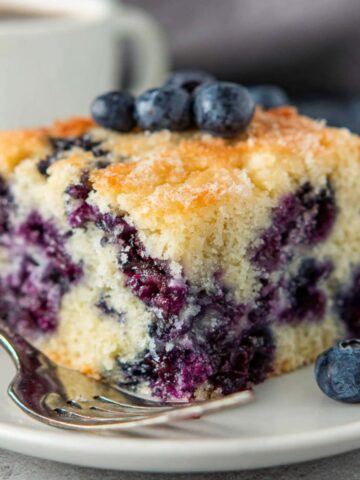






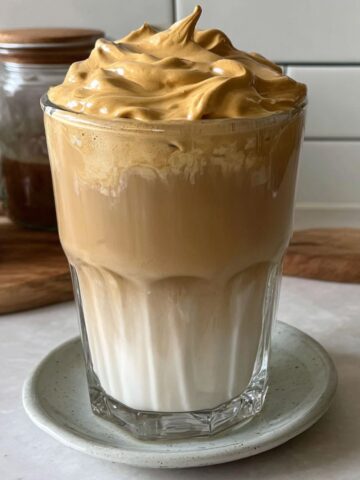




Leave a Reply